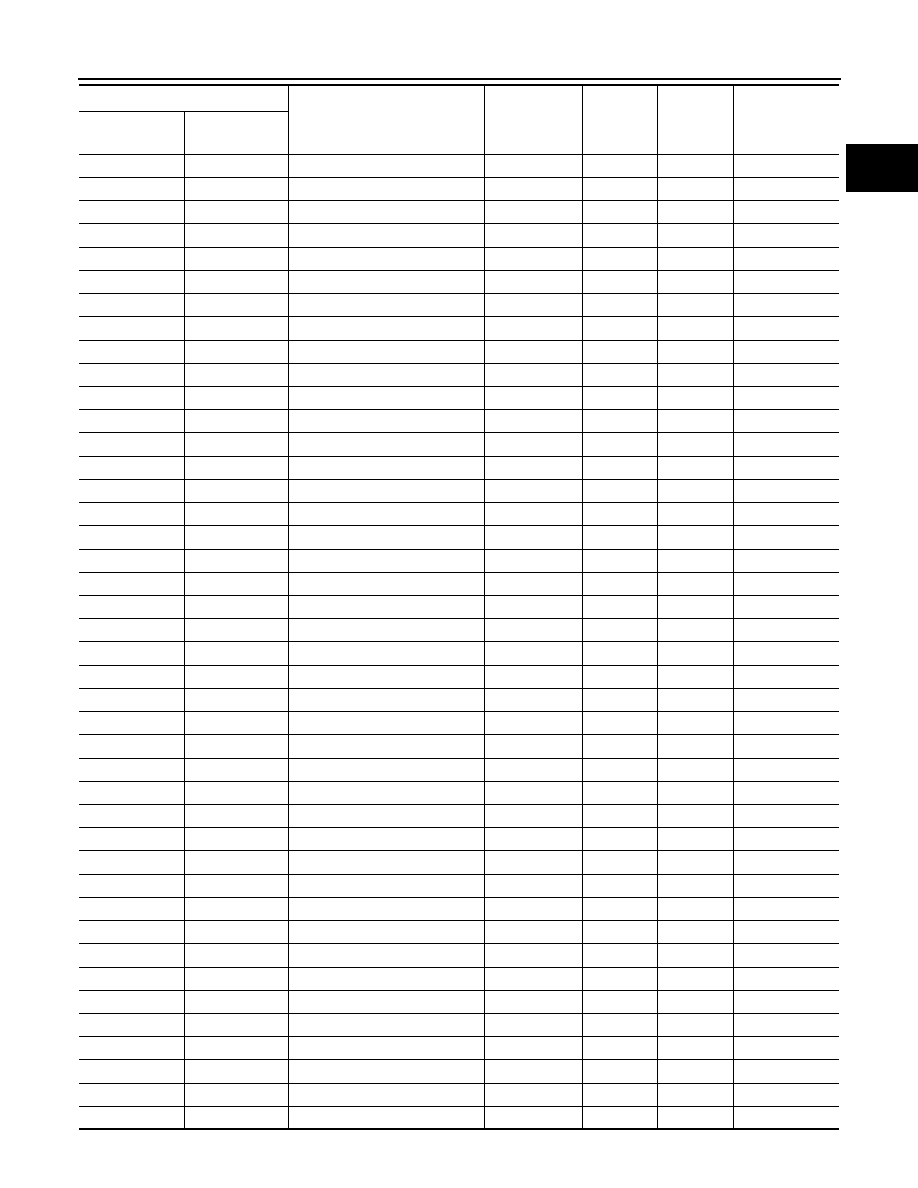Nissan GT-R (2007-2014 year). ENGINE CONTROL SYSTEM / ENGINE MECHANICAL. Service Manual - part 2

ECM
EC-17
< ECU DIAGNOSIS INFORMATION >
[VR38]
C
D
E
F
G
H
I
J
K
L
M
A
EC
N
P
O
P0850
0850
P-N POS SW/CIRCUIT
—
2
×
B
P1148
1148
CLOSED LOOP-B1
—
1
×
A
P1168
1168
CLOSED LOOP-B2
—
1
×
A
P1211
1211
TCS C/U FUNCTN
—
2
—
—
P1212
1212
TCS/CIRC
—
2
—
—
P1217
1217
ENG OVER TEMP
—
1
×
B
P1220
1220
FPCM
—
1
—
—
P1225
1225
CTP LEARNING-B1
—
2
—
—
P1226
1226
CTP LEARNING-B1
—
2
—
—
P1233
1233
ETC FNCTN/CIRC-B2
—
1
×
B
P1234
1234
CTP LEARNING-B2
—
2
—
—
P1235
1235
CTP LEARNING-B2
—
2
—
—
P1236
1236
ETC MOT-B2
—
1
×
B
P1238
1238
ETC ACTR-B2
—
1
×
B
P1239
1239
TP SENSOR-B2
—
1
×
B
P1263
1263
TC SYSTEM-B2
—
2
—
—
P1290
1290
ETC MOT PWR-B2
—
1
×
B
P1334
1334
TC SYSTEM-B2
—
1
×
B
P1421
1421
COLD START CONTROL
—
2
×
A
P1550
1550
BAT CURRENT SENSOR
—
2
—
—
P1551
1551
BAT CURRENT SENSOR
—
2
—
—
P1552
1552
BAT CURRENT SENSOR
—
2
—
—
P1553
1553
BAT CURRENT SENSOR
—
2
—
—
P1554
1554
BAT CURRENT SENSOR
—
2
—
—
P1564
1564
ASCD SW
—
1
—
—
P1572
1572
ASCD BRAKE SW
—
1
—
—
P1574
1574
ASCD VHL SPD SEN
—
1
—
—
P1610
1610
LOCK MODE
—
2
—
—
P1611
1611
ID DISCORD,IMMU-ECM
—
2
—
—
P1612
1612
CHAIN OF ECM-IMMU
—
2
—
—
P1614
1614
CHAIN OF IMMU-KEY
—
2
—
—
P1615
1615
DIFFERENCE OF KEY
—
2
—
—
P1805
1805
BRAKE SW/CIRCUIT
—
2
—
—
P2096
2096
POST CAT FUEL TRIM SYS B1
—
2
×
A
P2097
2097
POST CAT FUEL TRIM SYS B1
—
2
×
A
P2098
2098
POST CAT FUEL TRIM SYS B2
—
2
×
A
P2099
2099
POST CAT FUEL TRIM SYS B2
—
2
×
A
P2100
2100
ETC MOT PWR-B1
—
1
×
B
P2101
2101
ETC FNCTN/CIRC-B1
—
1
×
B
P2103
2103
ETC MOT PWR
—
1
×
B
P2118
2118
ETC MOT-B1
—
1
×
B
P2119
2119
ETC ACTR-B1
—
1
×
B
DTC*
1
Items
(CONSULT screen terms)
SRT code
Trip
MIL
Permanent DTC
group*
4
CONSULT
GST*
2
ECM*
3
Revision: 2012 November
2014 GT-R